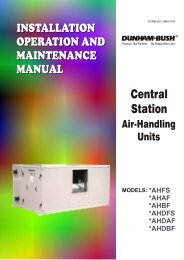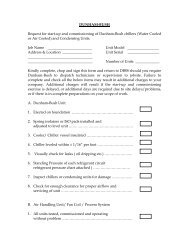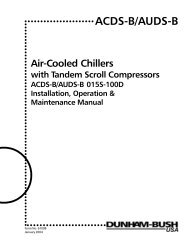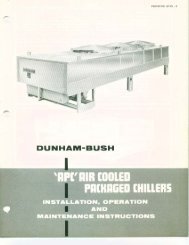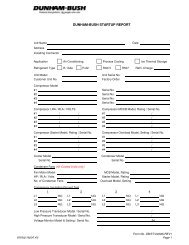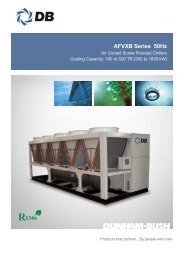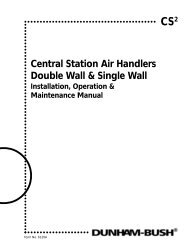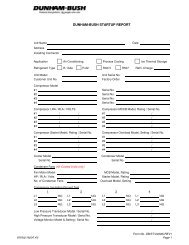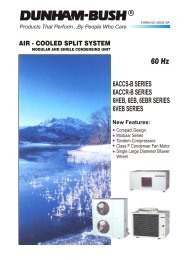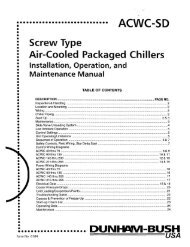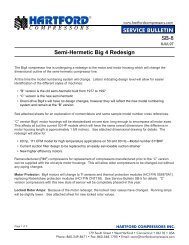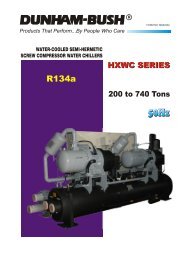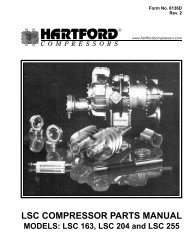IPCX Chillers - Dunham-Bush Americas
IPCX Chillers - Dunham-Bush Americas
IPCX Chillers - Dunham-Bush Americas
Create successful ePaper yourself
Turn your PDF publications into a flip-book with our unique Google optimized e-Paper software.
○ ○ ○ ○ ○ ○ ○ ○ ○ ○ ○ ○ ○ ○ ○ ○ ○ ○ ○ ○ ○ ○ ○ ○ ○ ○ ○ ○ ○ ○ ○ ○ ○ ○ ○ ○ ○ ○ ○ ○ ○ ○ ○ ○ ○ ○ ○ ○ ○ ○ ○ ○ ○ ○ ○ ○ ○ ○ ○ ○ ○ ○ ○ ○ ○ ○ ○ ○ ○○ ○ ○ ○ ○ ○ ○ ○ ○ ○○ ○ ○ ○ ○ ○ ○ ○ ○ ○ ○ ○ ○ ○ ○ ○ ○ ○ ○ ○ ○ ○ ○ ○ ○ ○ ○ ○<strong>IPCX</strong>Industrial RefrigerationRotary ScrewProcess <strong>Chillers</strong>Features• Uses HCFC-22 & compatible with alternate refrigerantssuch as R-134a, R-404a/R-507, R-717• Advanced microcomputer with open protocol• Most reliable screw compressor on market• Optional stacked or frame (skid) arrangements○ ○ ○ ○ ○ ○ ○ ○ ○ ○Form No. 6061-1A○ ○ ○ ○ ○ ○ ○ ○ ○ ○ ○
INTRODUCTION○ ○ ○ ○ ○ ○ ○ ○ ○ ○ ○ ○ ○ ○ ○ ○ ○ ○ ○ ○ ○ ○ ○ ○ ○ ○ ○ ○ ○ ○ ○ ○ ○ ○ ○ ○ ○ ○ ○ ○ ○ ○ ○ ○ ○ ○ ○ ○ ○ ○Industrial Refrigeration's <strong>IPCX</strong> Packaged Fluid <strong>Chillers</strong> are specificallydesigned for use in rugged industrial applications. Available in a wide range of capacities, fluidtemperatures and refrigerants, these chillers answer the needs of today's owners whoseapplications demand high quality, low maintenance, long life equipment. These packagesencompass thirty-five years of experience and dedication to rotary screw technologicaladvancements., the world's largest manufacturer of screw compressorizedair conditioning and refrigeration, has over 20,000 screw compressor installations worldwide.Understanding the specialized needs of the industrial user,IndustrialRefrigeration's experienced staff can custom engineer packages to meet virtually any customerrequirement. Cooling capacities range from 20 to 1000 tons with leaving fluid temperaturesfrom 50°F to -50°F or below. Most designs utilize R-22 as a standard refrigerant. Alternaterefrigerants include but are not limited to R-134a, R-404a/R-507, R-407C, R-410A and R-717. Alist of standard options is contained on pages 18 & 19, but there is virtually no limit to theoptionsIndustrial Refrigeration has available to answer any customer'sneed.Typical Stacked ArrangementQuiet, efficientopen drivecompressorControl PanelHorizontal OilSeparatorRemovable enhancedcopper tube DX heatexchanger, ASMECodedWhat is an Industrial Chiller?2External Oil PumpMicroprocessor or PLCfor precise and reliableWater-CooledcontrolOil Cooler<strong>IPCX</strong> Water-Cooled Rotary Screw Fluid <strong>Chillers</strong> are set apart by their ruggedhigh quality and DUTY SPECIFIC design.There are hardware considerations such as the industrial duty positive displacement screwcompressor—capable of operation over a wide range of conditions, open-direct drive motorson the compressor and external oil pump, vessel type and construction, along with industrialgrade controls.Of equal importance is theIndustrial Refrigeration sales, engineering andmanufacturing staff, experienced in servicing the unique needs of the industry. It is ourcommitment to consistently provide the highest quality product engineered to meet thedemands of our customers.Contact your localwhat Real SolutionsIndustrial Refrigeration Sales Representative to discusscan offer to meet your chiller needs.
UNIT FEATURES AND OWNER BENEFITS○ ○ ○ ○ ○ ○ ○ ○ ○ ○ ○ ○ ○ ○ ○ ○ ○ ○ ○ ○ ○ ○ ○ ○ ○ ○ ○ ○General• <strong>IPCX</strong> units, available in both stacked arrangements and frame (skid) arrangements, offer the mostflexible designs available, compared with other direct drive packages of similar tonnage.• A full compliment of operating and fail-safe electronic controls and devices render automaticoperation, afford protection for system components in the event of malfunction, and minimizeoperating costs.• No "on-location" assembly or painting is required. All <strong>IPCX</strong> packaged chillers have a fully operationalrun test prior to shipping. Unit is shipped requiring only primary fluid connections to the chiller andcondenser and electrical interconnection to starting equipment.Compressor Experience• Over thirty-five years of rotary screw compressor design technological advancements and fieldoperating experience.• Innovative design for high reliability has only two rotating parts.• Industrial grade dual-rotor rotary screw compressor with double-acting slidevalve for infinite capacity control to match load requirements, down to 10% of full load.• Many of our compressors have operated 100,000 hours and never been opened, let alone overhauled.• Insured continuous oil flow to the compressor through an external positive displacement oil pumpand high efficiency oil separator.Direct Drive Motor• Motors are open drip-proof, TEFC, explosion-proof or other specified enclosures, oeprating at 3550RPM - 60 HZ (2950 RPM - 50 Hz) with 115% service factor, factory mounted and aligned.Cooler and Condenser Vessels• Shell and tube vessel construction with individually replaceable tubes.• Standard vessel tubes are copper; copper-nickel tubes available as an option.• Standard vessel water connections are 150# raised face flanged connections. 300# raised faceflanges and victaulic connections are available as an option.• Marine water boxes are available as an option on water-cooled condensers and flooded evaporators.• The cooler has a single spring-loaded relief valve.• The condenser has dual spring-loaded relief valves mounted on a three-way selector valve.• Condenser sized to hold a full refrigerant charge; pumpout units are not required.Refrigerant Piping• The compressor is equipped with suction and discharge line check valves. The discharge valve ispiped between the oil separator and condenser and prevents refrigeration migration into theevaporator during off cycles and aids in unit servicing. The suction valve prevents reverse rotation.• Replaceable core liquid line filter-drier and sight glass/moisture indicator are standard.Refrigerant Compatibility• Designed to operate with environmentally safe and economically smart HCFC-22 with proven efficiencyand reliability.• Consult factory for use with alternate refrigerants.4
DESIGN FEATURES: DIRECT DRIVE TWIN-ROTOR SCREW COMPRESSORS○ ○ ○ ○ ○ ○ ○ ○Compressor AssemblyTherotary compressor is a positivedisplacement helical-axial design for use with highpressure refrigerants.• The compressor consists of two intermeshinghelical grooved rotors in a stationary housingwith suction and discharge gas ports.• Uniform gas flow, even torque and positivedisplacement, all provided by pure rotarymotion, contribute to vibration-free operationover a wide range of operating conditions.Intake and discharge cycles overlap effectively,producing a smooth, continuous flow of gas.Simplified Capacity ControlThe slide valve mechanism for capacity modulation andpart load operation is an outstanding feature:• Slide valve unloading provides the most efficientpart load unloading of any type of screwcompressor unloading.• Moving parts are simple, rugged and troublefree. The slide mechanism is hydrostaticallysupported with aid from a pressurized oilsupply.• Package capacity reduction can be as low as20% without HGBP by progressive movementof the slide valve.• Capacity reduction is programmed by anexclusive electronically initiated, hydraulicallyactuated control arrangement.• Any degree of part-load capacity at any headcondition can be accepted without duress forany period of time. The screw compressoractually operates cooler at partload conditions.Thrust BearingsEach rotor is fitted with a pair of preloaded, duplexmounted angular contact thrust bearings.These bearings are designed to safely carry thrust ineither direction at or near zero thrust loads. Additionallythe bearing races are mechanically locked to assure thatouter race rotation does not occur.Through the use of hydraulic counterbalancearrangements, the thrust bearings carry only a smallportion of the total thrust generated. This combinedsystem for carrying the thrust load is not affected byemergencies such as power outage, low oil pressuretrip-out or similar incidents.Main Journal BearingsHeavy duty, steel backed, field replaceable/serviceablebearings are conservatively loaded even at maximumoperating conditions. These bearings are center fed andsupplied with lubricant by an independently driven oilpump. Start-up lubrication is provided and “coastdown” lubrication is not required as the screwcompressor stops within a matter of seconds.RotorsThe latest <strong>Dunham</strong>-<strong>Bush</strong> patented asymmetrical designrotor profiles assure operation at highest efficiencies.Rotors are precision machined from AISI 1141 bar stockand dynamically balanced.CastingsCastings are manufactured with high grade, highdensity cast iron, externally ribbed for structural stabilityand efficient heat dissipation. Also, the cast ironprovides a high degree of noise reduction.Shaft SealA bellows type balanced shaft seal effectively seals thedrive rotor and provides a long operating life.6
DESIGN FEATURES: DIRECT DRIVE TWIN-ROTOR SCREW COMPRESSORS (CONT.)○○A. B. C.D.Compressor OperationNote: For clarity reasons, the following account of thecompressor operation will be limited to one lobe onthe male rotor and one interlobe space on the femalerotor. In actual operation, as the rotors revolve, all ofthe male lobes and female interlobe spaces interactsimilarly with resulting uniform, non-pulsating gas flow.Suction PhaseAs a lobe of the male rotor begins to unmesh from aninterlobe space in the female rotor, a void is createdand gas is drawn in tangentially through the inlet port- Fig. A. As the rotors continue to turn, the interlobespace increases in size - Fig. B, and gas flowscontinuously into the compressor. Before the point atwhich the interlobe space leaves the inlet port, the entirelength of the interlobe space is completely filled withdrawn-in gas - Fig. C.Compression PhaseAs rotation continues, the gas in the interlobe space iscarried circumferentially around the compressorhousing. Further rotation meshes a male lobe with theinterlobe space on the suction end and squeezes(compresses) the gas in the direction of the dischargeport. Thus the occupied volume of the trapped gaswithin the interlobe space is decreased and the gaspressure consequently increased.Discharge PhaseAt a point determined by the designed “built-in” volumeratio, the discharge port is uncovered and thecompressed gas is discharged by further meshing ofthe lobe and interlobe space - Fig. D. While the meshingpoint of a pair of lobes is moving axially, the next chargeis being drawn into the unmeshed portion and theworking phases of the compressor cycle are repeated.SLIDE VALVEFULLY CLOSEDFULL CAPACITYOUTLETFACEINLETFACEOUTLETFACESLIDE VALVEPARTIALLY OPENINLETFACEROTORHOUSINGROTORHOUSINGCapacity Control SystemFIGURE ASlide valve/rotor housing inlet endFigures A & B show the capacity control slide valvewithin the rotor housing. Axial movement of this valveis programmed by an exclusiveelectrically initiated (by variations in leaving chilled watertemperature) hydraulically actuated controlarrangement. When the compressor is fully loaded,the slide valve is in the closed position (Figure A).Unloading starts when the valve is moved back awayfrom the valve stop (Figure B). Movement of the valveFIGURE BSlide valve/rotor housing inlet endcreates an opening in the bottom of the rotor housing.Suction gas can then pass back from the rotor housingto the inlet port area before it has been compressed.Since no significant amount of work has been done onthis return gas, no appreciable power use is incurred.Reduced compressor capacity is obtained from the gasremaining in the rotors which is compressed in theordinary manner. Capacity reduction down to 20% offull load is possible by progressive movement of theslide valve away from the valve stop.7
UNIT FEATURES: CONTROL & STARTER PANELS○ ○ ○ ○ ○ ○ ○ ○ ○ ○ ○ ○ ○ ○ ○ ○ ○ ○ ○ ○ ○ ○ ○ ○ ○ ○<strong>IPCX</strong> packages are available with several types ofcompressor motor starting methods, depending onvoltage, for Remote Mounted and Unit Mountedapplications. All unit mounted starters are supplied inNEMA 12 enclosure. The unit controller and all otheroptions are in a separate enclosure.Unit mounted WYE-Delta Starters and Solid StateReduced Voltage are available for 460/3/60, 575/3/60and 400/3/50 voltage applications and are supplied fullyinstalled and wired with all starter options ordered. Allstarters include control transformer with primary andsecondary fuses, oil pump starter, oil pump overloads,undervoltage relay, and current transformer forcompressor motor load control.Remote mounted WYE-Delta Starters and Solid StateReduced Voltage starters are supplied for 460/3/60, 575/3/60 and 400/3/50. Across-The-Line Starters are suppliedfor medium voltage 2300/4160/3/60 and 3300/3/50applications.Solid State Reduced Voltage StartersUnit MountedSolid State Starters are unit mounted and wired in a NEMA12 enclosure, and offer many standard features:• Microprocessor controller• Bypass contactor for eliminating SCR heat generation• Programmable starting profiles• Controlled inrush current and torque• Stepless acceleration to full speed• Adjustable acceleration rate• Programmable motor protection• Under/over voltage and phase monitoring• Electronic overloads• Motor short circuit protection• Instant over current protection• Current imbalance• Ground fault interrupt• Embedded diagnostics• Integral display• Digital metering• Built-in self testing• Pending fault indicatorOptions• Unit Mounted Circuit Breaker—with disconnecthandle extended through the door• Unit Mounted Fused Disconnect—handle extendsthrough the door• Door Latch Solenoid—for power and control panelsSolid State Starters DBRSM6B are microprocessorcontrolledsolid state reduced voltage with easy-to-usekeypad interface. They operate on a user-programmedclosed-loop current ramp for optimum motor control andprotection.Solid State Starters are an excellent method of soft motorstarting, through solid state ramp control of voltage,current, speed and torque. The effect/benefit of the softstart is a reduction of both electrical and mechanical systemstress. This special solid state ramp control is shown in thefollowing diagrams.Programmable Ramp ProfilesPercentVoltage100%InitialTorque600%300%Initial Current100%0TorqueFullLoadTorqueMotorCurrentMax. AdjustedCurrent0 15Ramp Time (sec)DBRSM6B"Soft Start"Full VoltageStartAccelSpeed (RPM)Time (Seconds)FullSpeedProgrammable Speed / Torque CurvesTime(Sec)ProgrammableAccelerationTorqueTypical LoadStandard Features of the DBRSM6B Starter• Electronic Motor Overloads are Class 10, with 115%overload service factor for the DBRSM starters.• Initial Current is the starting point for the currentramp. It can be set between 50-400% of the motorFLA. This must be set so the motor starts turning whena start command is given.• Current Limit is the maximum motor current limitwith an adjustable current range from 200-600% ofthe full load current. This reduces the starting currentto limit brownout conditions during starting.Run9
UNIT FEATURES: CONTROL & STARTER PANELS (CONT.)○ ○ ○ ○ ○ ○ ○ ○ ○ ○ ○ ○ ○ ○ ○ ○ ○ ○ ○ ○99-event recorder. An event is considered anythingthat changes the present state which the starter is in,including faults, starts, stops, overload warnings, andoverload trips.• Programmable Service Factor is set to the servicefactor of the motor.• Real Time Clock with battery backup is included inthe starter. This allows the starter to track motorthermal overload content, enforce starter lockouttimes, and time stamp faults in the event recorder. Itwill track lockouts even when the power is removed.• Emergency Restart Provision has the ability tooverride the starter lockouts if it is necessary to startthe motor. This feature should only be used in theevent of an emergency.Wye-Delta StartersUnit MountedWye Delta Starters are unit mounted for 460/3/60, 575/3/60 and 400/3/50 applications and offer many standardfeatures mounted and wired in a NEMA 12 enclosure:• Closed Transition controller in a NEMA 12 enclosure• Controlled inrush current and torque to 33%• Two Step acceleration speed control• Ambient compensated overload relay• Under voltage, phase monitoring relayOptions• Unit Mounted Circuit Breakers—with disconnecthandles extended through the door• Unit Mounted Fused Disconnect—handles extendedthrough the door• Ground Fault Interrupt Relay• Under and Over Voltage, Phase Loss, and PhaseImbalance Relay• Volt and Amp Meters—with selector switches forthree phase meter reading• Door Latch Solenoid—for power and control panelsWYE Delta Closed Transition Starters (also called Star DeltaStarters) - offer a reduced voltage/reduce inrush currentmethod of starting motors. WYE Delta starters utilizespecial wound motors that can be connected to the "Y"pattern for reduced starting torque. In the "Y"configuration, each set of phase windings is broughttogether at a common point. This increases the impedanceof the motor itself, reducing the current and torque to33% of normal. Three contactors and a timer are used toswitch the six leads brought out of the motor into the Y-then-Delta configuration in a two-step starting process."Closed Transition" WYE Delta starters utilize shunt resistersin the circuit during the transition phase of starting toprevent motor stalls or current spikes. This scheme usesfour contactors in three steps and large starting resisters.Step 1, Y StartContactors 1M and S close2M is openT1WYE Delta Wiring ConfigurationT4T5 T6T32MT21M1MT5Winding pattern "Y"33% torque, 33% currentT2T4ST61MT1 2MT32MWinding pattern "Delta"Full torque, Full currentStep 1, Delta RunContactor 2S opens1R closesT4T2This method is superior to Across-The-Line motor startingdue to the reduced electrical demand, in areas with highelectrical rates and utility demand charges.Remote MountedRemote Mounted WYE Delta Starters offer the samestandard features and options as the Unit MountedStarters, and are supplied in a stand alone NEMA 1enclosure, for contractor mounting and wiring. Terminalsare marked for interconnecting wiring, from the remotestarter to the chiller, for ease of wiring.Across-The-Line StartersRemote MountedRemote Mounted Starters are available for medium voltage2300/4160/3/60 and 3300/3/50 voltage applications. Othervoltages are available by contacting our SalesRepresentative or Application Engineering Department.Across-The-Line Starters are supplied in NEMA 1 enclosuresand have the many standard features:• Control Power Transformer with primary andsecondary fusing• Ambient compensated overloads• Current transformers• 4-20mA load signal• Oil Pump Starter with overload protection• Under voltage and phase monitoring relay• Draw out contactor with fused isolation switchOptions• Ground Fault Interrupt Relay• Under and Over Voltage, Phase Loss, and PhaseImbalance Relay• Volt and Amp Meters—with selector switches forthree phase meter reading• Door Latch Solenoid—for power and control panelsT1T6T5T311
DESIGN FEATURES: MICROCOMPUTER CONTROL○ ○ ○ ○ ○ ○ ○ ○ ○ ○ ○ ○ ○ ○ ○ ○ ○ ○ ○ ○ ○ ○ ○ ○ ○Advanced Microcomputer Control is a standard featureon allRotary Screw <strong>Chillers</strong>monitoring analog and digital inputs to achieve precisecontrol of the major operational and protectivefunctions of the unit.Direct digital control (DDC) allows fingertip userinteraction. Its simple-to-use push button keyboard andmenu-driven software provide access to operatingconditions, control setpoints and alarm history clearlydisplayed on a prominent multi-line 80 characteralphanumeric display.An easy-to-install, inexpensive modem option allowsremote reading of operating parameter updates. Themicrocomputer insures its ownerstate-of-the-art efficiency and reliability.Display InformationThe 80 character alphanumeric liquid crystal displayutilizes easy-to-understand menu-driven software.Inexperienced operators can quickly work through thesemenus to obtain the information they require or tomodify control parameters. More experienced operatorscan bypass the menu systems, if desired, and movedirectly to their requested control function. At all times,assistance is available to the operator by simply pressingthe help key. Easily accessible measurements include:• Entering and Leaving chilled fluid temperature• Suction pressure and temperature• Discharge pressure and temperature• Oil pressure and temperature• Compressor motor amp draw• Compressor elapsed run time• Percent of slide valve loading• Reservoir oil temperature• Fluid temperature reset value• Demand limit reset value• Compressor starter status• Oil pump starter status• Fluid flow switch status• External start / stop command statusCapacity ControlLeaving chilled water temperature control isaccomplished by entering the leaving water temperaturesetpoint and placing the microcomputer in automaticcontrol. The unit will monitor all control functions andmove the slide valve to the required operating position.The compressor ramp (loading) cycle is programmableand may be set for specific building requirements.Remote adjustment of the leaving chilled water setpointis accomplished through either direct connection viaterminal or modem connected to the RS232communication port, or from an external BuildingAutomation System supplying a simple 0 to 5 VDCsignal. Remote reset of compressor current limit maybe accomplished in a similar fashion.System ControlThe unit may be started or stopped manually, or throughthe use of an external signal from a Building AutomationSystem. In addition, the microcomputer may beprogrammed with a seven-day operating cycle or othercontrol packages may start and stopthe system through inter-connecting wiring.Optional watering temperature monitoring (WTM) forentering and leaving condenser water temperature isavailable. With this option the operator can quicklyand accurately read the water temperatures andeliminate the need for thermometers.14
DESIGN FEATURES: MICROCOMPUTER CONTROL (CONT.)○ ○ ○ ○ ○ ○ ○ ○ ○ ○ ○ ○ ○ ○ ○ ○ ○ ○ ○System ProtectionThe following system protection controls willautomatically act to insure system reliability:• Low suction pressure• High discharge pressure• Low oil pressure• Freeze protection• High oil temperature• Compressor starter failure• Oil pump starter failure• Compressor run error• Power loss• Chilled water flow loss• Sensor error• Compressor overcurrent• Anti-recycleAlarm HistoryThe microcomputer retains the latest eight alarm conditionscomplete with time of failure in its alarm history.This tool aids service technicians in troubleshootingtasks enabling downtime and nuisance trip-outs to beminimized.Remote Monitoring CapabilityThe microcomputer is complete with an RS232communications port and all hardware and softwarenecessary to remotely monitor and control the packagedchiller up to 50 feet away (hard wired) or by optionalphone modem for extended distances by the phonesystem. This valuable enhancement to the chiller systemallows the ultimate in serviceability. The microcomputeris equipped with history files as standard which recordsa history that may be retrieved via the phone modemperiodically. Now owners of multiple buildings have asimple and inexpensive method of investigatingpotential problems quickly and in a highly cost effectivemanner.Remote Monitoring and OperatingTerminalsThere are four methods of remote monitoring andoperating our package chillers.1) RMDT - Remote Monitor DisplayTerminalThe RMDT (Remote Monitor Display Terminal) can behard wired up to 50 feet away from the chiller orconnected thru a modem for remote monitoring andoperating of up to three chillers. The RMDT is suppliedwith a 14" monitor, two RS232 serial ports, a 6 foot115 volt power cord and an enhanced PC keyboard.This option allows remote start-stop, chilled water setpointchanges, and reading of all microcomputerscreens including operating conditions, faults and faulthistory.2) IBM PC Compatible Computer TerminalA customer's IBM PC Compatible computer withcommunication software installed (simple terminal) caninterface with the chiller in the same manner as theRMDT (Remote Monitor Display Terminal). Again, thismethod of communication interfaces with the chillermicrocomputer CPU and provides the same level ofcommunication.3) BMS - Building Management SystemTerminalA BMS (Building Management Systems) may interfacewith the chiller microcomputer and provide the samelevel of monitoring and operating control as above,when the BMS company has implemented thecommunications protocol.has an open communicationsprotocol policy with most BMS companies.15
DESIGN FEATURES: MICROCOMPUTER CONTROL (CONT.)○ ○ ○ ○ ○ ○ ○ ○ ○ ○ ○ ○ ○ ○ ○ ○ ○ ○ ○Terminal InterfacingUsing any one method shown below.4) CHLK - ChillerLINKhas always been a strong advocateof open systems communications. This has been evidentin the past with the publication of our network protocol,and now once again through our interoperability withBACnet. In addition to BACnet, the modular design ofour ChillerLINK also supports Modbus protocol. Consultwith <strong>Dunham</strong>-<strong>Bush</strong> to verify compatibility with otherprotocols.’s ChillerLINK is a microprocessorbasedcommunication device designed to provideseamless, two-way translation between a <strong>Dunham</strong>-<strong>Bush</strong>microcomputer and a BACnet or MODBUS compliantnetwork or work station. ChillerLINK devices can beset for two Data Link/Physical Layer configurations:1. PTP (point-to-point) via EIA-232 standard2. EIA-485 standard for 2-wire or 4-wire systemsIn addition to providing seamless interoperability withBACnet or MODBUS systems, ChillerLINK can be speciallydesigned for full custom programmability of the dataflowing between the <strong>Dunham</strong>-<strong>Bush</strong>/BACnet/MODBUSnetworks.16
DESIGN FEATURES: PART-LOAD PERFORMANCE○ ○ ○ ○ ○ ○ ○ ○ ○ ○ ○ ○ ○ ○ ○ ○ ○ ○ ○ ○ ○ ○ ○ ○ ○ ○<strong>IPCX</strong> Rotary Screw Water <strong>Chillers</strong>possess superior part-load performance characteristics.This is accomplished with the infinite capacity controlcapability of the slide valve equipped compressor.Actual process loads are significantly less than full loaddesign conditions, therefore chillers operate at full loadfor only a fraction of the operating time.<strong>IPCX</strong> Rotary Screw Water <strong>Chillers</strong>combine the efficient operation of the rotary screwcompressor with finite refrigerant management andmicroprocessor control to yield the best total energyefficiency and significant operating savings under anyload.When specifying process cooling equipment it isimportant to consider the system load characteristicsof the process application. In a typical city, the airconditioning load will vary according to changes in theambient temperature. Weather data compiled overmany years will predict the number of hours thatequipment will operate at various load percentages.The Air Conditioning and Refrigeration Institute (ARI)has established a system, in ARI 550/590-98, formeasuring total chiller performance over full and partloadconditions. The Integrated Part-Load Value (IPLV)is an excellent method of comparing diverse types ofequipment on an equal basis. The IPLV is a singlenumber estimate of a chiller’s power use weighted forthe number of hours the unit might spend at eachpart-load point. IPLV’s are based on Standard ARI RatingConditions.For COP and EER:IPLVorNPLVFor kW/ton:= 0.01A+0.42B+0.45C+0.12D (1a)where: A = COP or EER at 100%B = COP or EER at 75%C = COP or EER at 50%D = COP or EER at 25%IPLVor =10.01 0.42 0.45 0.12+ + +A B C DNPLVwhere: A = kW/ton at 100%B = kW/ton at 75%C = kW/ton at 50%D = kW/ton at 25%(1b)Non-Standard Part-Load Values (NPLV) also give asingle number estimate for the part-load performanceof a chiller but at Selected Application RatingConditions.Integrated Part-Load Values and Application Part-LoadValues are available from your <strong>Dunham</strong>-<strong>Bush</strong>Representative and will be calculated for your specificconditions. These points, as well as the full loadselection point, are all covered under the ARI LargeTonnage Certification Program for Centrifugal andRotary Screw Water-Chilling Packages.17
OPTIONS○ ○ ○ ○ ○ ○ ○ ○ ○ ○ ○ ○ ○ ○ ○ ○ ○ ○ ○ ○ ○ ○ ○ ○ ○ ○ ○ ○ ○ ○ ○ ○ ○ ○ ○ ○ ○ ○ ○ ○ ○ ○ ○ ○ ○ ○ ○ ○ ○ ○ ○ ○ ○ ○ ○offers many factory installed andtested options for "custom solutions" to everyday ownerand operator special requirements:WYE—Delta Starter—is available for 460/3/60, 575/3/60 and 400/3/50 voltage unit applications. The Y-Deltaelectromechanical method of starting is supplied builtinto the power section of the unit starter and controlpanel. Y-Delta starting has a long history of startingthis type of mechanical equipment. See Unit Featuressection of this catalog for details.Solid State Starter—is available for 460/3/60, 575/3/60 and 400/3/50 voltage unit applications. This stateof-the-artstarting method provides soft-starting withreduced mechanical and electrical stresses. See UnitFeatures section of this catalog for details.Remote Across-the-line starter—is available for2300/3/60, 4160/3/60 and 3300/3/50 supply voltage unitapplications. This method of starting equipment issupplied with a stand-alone remote NEMA 1 enclosureand a fused isolation switch. See details in the UnitFeatures of this catalog.Circuit Breaker—for 460/3/60, 575/3/60 and 400/3/50 voltage units which provide short circuit protectionfor the unit and is supplied with a disconnect handleand hardware extended through the control box door.Fused Disconnect—for 460/3/60, 575/3/60 and 400/3/50 voltage units which provide a unit mounteddisconnect and is supplied with a disconnect handleand hardware extended through the control box door.Optional Motors—standard motor enclosures areODP. TEFC, Explosion Proof, WPI and II are also availableon select sizes and voltages.Ground Fault Interrupt Relay—takes the unitoff the line if a ground fault is detected.Volt and Amp Meters—provide both volt and ampmeters mounted in the control box door with selectorswitches to allow readings of each power phase.Over and Under Voltage and PhaseProtection Relay—protects against high and lowincoming voltage conditions as well as single phasing,phase reversal and phase imbalance by opening thecontrol circuit. The UVR2 is an automatic reset device,but the unit microcomputer controller can be set upfor manual reset to prevent unwanted restarts.Alarm Bell—mounted and wired to a common alarmfault.Electric Panel Door Latch Solenoid—providessafety and security required by local codes. Main powermust be disconnected to gain entry to the power andcontrol electrical panels. The control panel can beaccessed with a key-lock actuated override switch.ChillerLINK—for communication with (BMS) buildingmanagement systems through BacNet or Modbus. Seedetails in unit features of this catalog.Systems International Display—providesmicrocomputer controller information displayed in SIUnits. The microcomputer controller display defaultsto English Units unless the computer is set up for SIunits. (Temperature in °C and pressure in BARS.)Remote Monitoring Modem—for long distancecommunication, allows the system to be monitored andhistory logs retrieved to assist with investigatingpotential problems quickly and in a cost effectivemanner from a remote source.Refrigerant Sensor—senses refrigerant in theequipment room between the chiller vessels and reportsthis information to the unit microcomputer controller.Condenser Water Temperature Monitoring—two extra temperature sensors (shipped loose for fieldwiring to the microcomputer controller), for monitoringof entering cooler water temperature, leaving condenserwater temperature, and entering condenser watertemperature. These sensors are for information only.Condenser Water Control—provides an analogoutput that can be used to control condenser waterflow. The 0-5VDC or 0-10VDC signal increases asdischarge pressure rises above a setpoint (TYP 160 psig).This should produce an increase in the condenser waterflow.Shipping Less Refrigerant—for shipping unitswithout the refrigerant charge. The chiller will be builtand tested and the refrigerant removed after testing.Optional Panel enclosures—Control panel andstarter panels available in NEMA 4, NEMA 4X (stainlesssteel and fiberglass), Purged and pressurized panels (forClass I, Div II, Group C & D classifications), NEMA 718
OPTIONS (CONT.)○ ○ ○ ○ ○ ○ ○ ○ ○ ○ ○ ○ ○ ○ ○ ○ ○ ○ ○ ○ ○ ○ ○ ○ ○ ○ ○ ○ ○ ○ ○ ○ ○ ○ ○ ○ ○ ○ ○ ○ ○ ○ ○ ○ ○ ○ ○ ○ ○Optional Wiring Conduit—Sealtite, Rigid and PVCcoated Rigid is availableOptional Controllers—Optional controllers suchas Allen-Bradley, Modicon and Bailey PLC's are just afew of the optional controllers available.Optional Vessels—Vessels are available in alternatematerials of construction. These include but are notlimited to: stainless steel tubes and shells, cupro-nickeltubes. Alternate vessel codes such as TEMA B, C and Rare available.Optional Piping Specialties:• Compressor isolation valvesAllows for the service or removal of compressor• Dual oil filters with bypass valveAllows for servicing of oil filter without shutdowndown package• Dual filter driers with bypass valveAllows for servicing of filter drier without shutdownof package• Major component isolation valvesAllows for servicing or replacement of majorcomponentsOptional Arrangements—<strong>IPCX</strong> Packaged<strong>Chillers</strong> are available in space saving "stacked"arrangement as well as structural steel (skid)arrangements.This is a partial list of common options and accessoriesavailable on <strong>IPCX</strong> packages. In an effort to be responsiveto particular customer's needs,will consider any request. Contact your localrepresentative for details.Low Temperature <strong>IPCX</strong>180 for large pharmaceutical company. Unit coolsethylene glycol to -20°F. Options include Allen-Bradley PLC, NEMA 4control panel, Rosemount transmitters and TEMA C heat exchangers19
INSTALLATION DATA○ ○ ○ ○ ○ ○ ○ ○ ○ ○ ○ ○ ○ ○ ○ ○ ○ ○ ○ ○ ○ ○ ○ ○ ○ ○ ○ ○ ○ ○ ○ ○ ○ ○ ○ ○ ○ ○ ○ ○ ○ ○ ○ ○ ○Chilled Water FlowThe<strong>IPCX</strong> Packaged Water Chilleris designed for a constant chilled water flow rate evenwhen the cooling load is varying. The machine willgenerally perform satisfactorily with steady flow ratesdeviating from design by as much as +10% to -50%.However, varying water flow rates can cause controlinstability which will result in undesirable system effects,particularly poor control of leaving chilled watertemperature. If two-way valves are used to control flowthrough cooling coils, some means such as an automaticmodulating valve should be provided in the system tomaintain steady flow through the cooler.Multiple Unit ControlOne of the most perplexing problems to systemdesigners is control of multiple chillers on the samewater loop. The first decision is whether to put thechillers in parallel or series on the chilled water side. Iflower pumping cost is paramount, then putting chillersin series is often preferable. If primary/secondarypumping is utilized with normal 10°F (6°C) range, thenputting chillers in parallel is normally used. In eithercase, themicrocomputer (withspecial programming) can control up to three chillers.This eliminates the need for external control interfacewhich often becomes difficult. Contact the factory ifmore than three chillers need to be networked.Condensing Water TreatmentCondensing water tends to leave silt, algae and mineraldeposits in the condenser tubes. This fouling graduallydecreases unit efficiency. For this reason, a program ofwater treatment should be employed. Also, at regularintervals depending an water quality, the unit shouldbe shut down, condenser heads removed and tubescleaned.FoundationA flat, level concrete foundation or floor capable ofsupporting the weight of the unit must be provided.The unit must be levelled to within 1/16 inch per foot(1.6mm per 30.5cm) for proper operation.Vibration IsolationWhere structure-borne vibration may be of concern, itis recommended that the unit be mounted on vibrationisolators. Spring isolators are available for this unit asoptional equipment. If spring isolators are installed, itis also necessary to provide isolation in condenser waterand chilled water pipes by means of flexible connectorsand in main power supply conduit through use offlexible conduit. Isolation of piping and electricalconduit is desirable in any event to avoid noisetransmission.Location and Installation Suggestions<strong>IPCX</strong> Packaged <strong>Chillers</strong> are typically designed forindoor application. Proper locations and installationprocedures for this equipment are very important forsuccessful trouble free operation. It is desirable to installthese units with sufficient service space on all sides ofthe unit. Tube cleaning and unit servicing requireconsiderable space at the ends of the units as shown inthe dimensional outline section of this catalog.Compressor and motor servicing require space at therear of the unit. NEC and Local Codes require a minimumof 36 to 48 inches in front of the unit depending onthe application location.Equipment Location and Unit SecurityThe <strong>IPCX</strong> is a quiet operating chiller but soundsensitivity should be considered when locating thisequipment. Equipment and equipment rooms need tobe located in areas of the building that will not disturbsurrounding occupied spaces. Equipment rooms canbe acoustically designed for sound sensitive installationsto minimize sound transmission into occupied spaces.It is suggested that an acoustical Engineer be consultedon critical sound and vibration applications before,rather than after, the equipment is installed. Unitsecurity and personal safety should also be consideredwhen locating this equipment. All state and local soundand safety codes should be considered when laying outor installing mechanical equipment.Cooler - Freeze ProtectionThe leaving water sensor mounted on the Cooler willshut down the unit if a cooler freeze condition shouldoccur. A water flow switch must be supplied andmounted in the water piping to protect the unit fromlow or no flow, which can cause cooler freezing.Electrical Connection OptionsAll wiring must be done in accordance with the NationalElectric Code (NEC) and all local and state codes. Acomplete set of wiring diagrams for all units is availablefrom ourSales Representative. Theunit will be shipped with wiring diagrams located inthe electrical panel.20
INSTALLATION DATA (CONT.)○ ○ ○ ○ ○ ○ ○ ○ ○ ○ ○ ○ ○ ○ ○ ○ ○ ○ ○ ○ ○ ○ ○ ○ ○ ○ ○ ○ ○ ○ ○ ○ ○ ○ ○ ○ ○ ○ ○Low Voltage Units460/3/60, 575/3/60 & 400/3/50 voltage applications canbe supplied with unit-mounted, Solid State ReducedVoltage or Wye-Delta starter panel. Optional remotemountablestarter panels can also be supplied. All threelow voltage starter panels are for single point powersource.Medium Voltage Units2300/3/60, 4160/3/60 & 3300/3/50 applications aresupplied with remote-mounted across-the-line starterpanel.Power SourcesThe term “Power Source” refers to the unit main powersupply.For unit mounted starters, control power is supplied bya unit mounted control transformer. <strong>Dunham</strong>-<strong>Bush</strong>supplied remote mounted starters also include a controlcircuit transformer to provide 115 VAC.Medium voltage units require a separate 460/3/60 or400/3/50 power source for the oil pump and controlpower transformer.Unit and Field Mounted Disconnects“Disconnecting means” are described in Article 440 ofthe National Electric Code (NEC) which requires“disconnecting means capable of disconnecting airconditioning and refrigeration equipment includingmotor-compressors, and controllers from the circuitfeeder”. If the fused disconnect option is not supplied,then the disconnects by others should be selected andlocated within the NEC guidelines. Locationrequirements, per NEC, indicate that the disconnect belocated in a readily accessible position within sight (50feet) of the unit.Control Circuits115 volt control circuit terminals are clearly marked onthe electrical diagram found in the control panel forcontrol power.Contact our Application Engineering Department forhelp with other requirements.Cooler Design Data1. Maximum—LCFT (Leaving Chilled FluidTemperature) is 50°F (10°C). The unit can start andpull down with up to 90°F (32.2°C) entering watertemperature.2. Minimum—LCFT is 38°F (3.3°C) for all unit modelsbeing applied to water applications using standardcoolers. Consult factory for other operatingconditions below 38°F (3.3°C) using alternatecooling fluids.3a. Two Pass Flooded Coolers are considered Standardand are used for most Air Conditioning and ProcessApplications. They have a chilled fluid temperaturedifference range from 8° to 14°F (4.4° to 7.8°C).Consult factory for all special applications.3b. Single Pass DX Coolers are used for NarrowTemperature Range Applications, and have a chilledfluid temperature difference range from 3° to 10°F(1.7° to 5.6°C). Consult factory for specialapplications.4. Wide Range - Low Flow Chiller Operation can beaccomplished with a by-pass recirculation methodof piping, to allow the chiller to operate withacceptable flow rates as shown in Figure 26A. Thisis a suggested arrangement and special engineeringof piping, valving, and sensor locations is requiredto ensure proper operation.5. For Extra Narrow and Wide Range Applications,a by-pass piping arrangement can be used similarto Figure 26B. This is a suggested arrangement andspecial engineering of piping, valving, and sensorlocations is required to ensure proper operation.21
APPLICATION DATA○ ○ ○ ○ ○ ○ ○ ○ ○ ○ ○ ○ ○ ○ ○ ○ ○ ○ ○ ○ ○ ○ ○ ○ ○ ○ ○ ○ ○ ○ ○ ○ ○ ○ ○ ○ ○ ○ ○ ○ ○ ○ ○ ○ ○ ○Chilled Fluid Loop Volume (CFLV)Figure 22ACareful consideration needs to be given to the “ChilledFluid Loop Volume” (CFLV) or System / Inertia tomaintain an acceptable leaving fluid temperature.FLUID - INSmall Loop Volume Systems may have temperaturecontrol problems due to the small fluid volume in thesystem. This “System Inertia Problem” is exaggeratedat low load conditions and causes chiller to short cycle.The small fluid volume in the system will be pulled downto setpoint in a very short period of time, and the chillerwill be shut down. The chiller's anti-recycle timer limitsthe number of starts to three per hour. The system looptemperature will warm up during this off cycle and mayrequire cooling before the anti- recycle timer has timedout. Once the anti-recycle timer has timed out the unitwill re-start and the chiller will again load up possiblyto 100% and pull the loop down again repeating theshort cycle pattern.The System Loop Volume should be sized to limit thetemperature rise that can occur during the off cycle.Air Conditioning ApplicationsThe chilled fluid loop volume must be at least 3 gallonsper nominal ton of cooling (3.25 L per kW).Process & Special Air Conditioning ApplicationsWhere leaving fluid temperature is often more critical,the chilled fluid loop volume should be increased to 10to 15 gallons per ton (10.8 to 16.2 L per KW).COOLERTEMPERATURESENSORSFLUID - OUTCONTACT FACTORY FOR ADDITIONAL SENSORAND CONTROL SCHEMEFLUID INCOOLER3. Series Chiller Applications (Figure 22B). Where alarge temperature range is required (generally over15°F [8.4°C]), the chiller may be piped in series. Ifload balancing is not required, the units arecontrolled independently. Chiller Number 1 willoperate up to full load when the systemrequirements are within its capability.If load balancing is required, special programmingand interconnecting wiring are required. The loadis progressive by temperature so the chillerselections are critical.Figure 22BMultiple <strong>Chillers</strong> Per Chilled Water System1. Where the load is greater than one can supply orwhere standby capacity is required or the loadprofile dictates, multiple chillers may be piped inparallel. Units of equal size help to ensure fluidflow balance, but balancing valves ensure balancedflows even with dissimilar chillers. Temperaturecontroller sensors may or may not need to bemoved to the common fluid piping depending onthe specific application.COOLERNo. 2TEMPERATURESENSORTEMPERATURESENSORCOOLERNo. 12. Parallel Chiller Applications (Figure 22A). Both unitsoperate simultaneously modulating with loadvariations. Each unit operates independentlysensing its own leaving water temperature. Theset point of each sensor is set to maintain thedesired loading scheme.FLUID OUTIf unit sequencing is required, special programmingand interconnecting wiring are required. Additionalwater control piping may also be required.22
APPLICATION DATA (CONT.)○ ○ ○ ○ ○ ○ ○ ○ ○ ○ ○ ○ ○ ○ ○ ○ ○ ○ ○ ○ ○ ○ ○ ○ ○ ○ ○ ○ ○ ○ ○ ○ ○ ○ ○ ○ ○ ○ ○ ○Oversizing <strong>Chillers</strong>Oversizing of chillers more than 10-15% is notrecommended. Oversizing causes energy inefficiencyand shortened compressor life due to excessivecompressor cycling. Larger future load requirementsmay cause temporary oversizing of equipment whichwill require careful unit selection. It may be better toproperly size for the present load and add another unitlater for future expansion. It is also recommended usingmultiple units where operation at minimum load iscritical. Fully loaded equipment operates better andmore efficiently than large equipment running at ornear minimum capacity.Hot gas bypass should not be a means to allowoversizing of chillers. Hot gas bypass should only beused where the equipment is sized properly for fullload but the load turn down is less than the minimumunloading capacity available.Water (Fluid) StrainersIt is recommended that 40-mesh strainers be installedin the fluid piping as close to unit cooler as possible toprevent plugging or damage to the tubes.Cooling Tower Control and CondenserApplication Design DataCooling Tower and Head Pressure Control isimperative for proper trouble free chiller operation.There are several methods of tower and head pressurethat we will discuss below.Condenser Water Temperature should never go below60°F (15.6°C) and its rate of change should not be rapid.Rapid is defined as not exceeding 2°F (1.1°C) per minute.If this cannot be guaranteed, then other controls suchas tower dampers, tower sump heater, 3-way towerbypass valve, 2-way tower throttling valve or variablespeed condenser pumping must be utilized. This isnecessary because a chiller operates in a dynamicenvironment and is designed to maintain a preciseleaving chilled water temperature under varyingentering conditions. The additional dynamics of rapidlyvarying condenser water temperature subjects themachine to fluctuating pressure differentials across thecooler and condenser. This varies the refrigerant flowand, therefore, the capacity and efficiency of the chiller.If this occurs faster than the machine canaccommodate, the head pressure or suction pressurewill soon exceed their safety setpoints and the machinewill shut down. Through an optional analog outputboard, the microcomputer can control the bypass orthrottling valve directly from condenser pressure, bysending a 0 to 10 VDC signal to a direct current, valvemotor actuator.Themicrocomputer can provide adigital signal to enable the control circuit of the tower.Condenser Water Regulating Valves are a desirablemethod of head pressure control, because they responddirectly to changes in head pressure and provide themost stable method of head pressure control. Stablehead pressure control allows the chiller to operate atthe best efficiency for the load conditions. Regulatingvalves can be supplied as an option. These can beshipped loose or factory mounted and piped.Cooling Tower and Head Pressure Control can beattained via fan cycling if the tower is rated at the samecapacity as the chiller, and the machine will operate atdesign conditions under heavy load. On multiple chillerinstallations, a single tower may be sized, for a multipleof the individual chillers. If this is true and only onemachine is running, the tower is then oversized, relativeto the individual chiller needs, and head pressurecontrol becomes a challenge. On other installations,the tower/chiller might be oversized to the design loadand the machine and tower frequently cycle under lightloads. Under these conditions, fan cycling might resultin very rapid temperature swings, which creates adynamic situation that occurs faster than the chillercontrol system can accommodate. Variable speed fansor modulating valve control should be used to maintainsystem stability.Fan Cycling Tower Control is one method of headpressure control, but this type of control does not workfor all systems. We recommend that the condenserwater pump control through the unit interlock, in thechiller control panel, be used to enable and disablethe condenser water pumps. We further recommendthat the designer carefully evaluate the system todetermine a precise method of tower fan and waterpump temperature control for the most efficientmethod of head pressure control.1. Minimum—ECWT (Entering Condenser WaterTemperature) is 60°F (15.6°C) to start the unit, andmaintain head pressure control for proper unitoperation. The water temperature change ratemust be less than 2°F (1.1°C) per minute to assureproper chiller operating stability. This is necessarybecause it operates in a dynamic environment.Head pressure through water regulating controlvalves or bypass piping should be used where lowerECWT is expected.23
APPLICATION DATA (CONT.)○ ○ ○ ○ ○ ○ ○ ○ ○ ○ ○ ○ ○ ○ ○ ○ ○ ○ ○ ○ ○ ○ ○ ○ ○ ○ ○ ○ ○ ○ ○ ○ ○ ○ ○ ○ ○ ○ ○ ○2. Maximum—ECWT (Entering Condenser WaterTemperature) is 95°F (35°C) without loss of unitcapacity or potential high condensing temperature/pressure shutdown. The water temperature changerate must be less than 2°F (1.1°C) per minute toassure proper chiller operating stability. For highercondenser entering water temperature, consult thefactory.3. Unit Operating Efficiency and trouble freeoperation is greatly influenced by the enteringcondenser water temperature, proper flow, and themean temperature of the condenser water.4. Wide Condenser Water Temperature Ranges forunits operating with 95° ECWT (35°C) and higher,and wider than 10°F (5.6°C) range, increases theunit condensing temperature and decreases theunit efficiency. This situation is usually found inapplications with undersized condenser watertowers.Glycol Freeze ProtectionIf the chiller or fluid piping may be exposed totemperatures below freezing, glycol protection isrecommended if the water is not drained. Therecommended protection is 10°F (5.6°C) below theminimum ambient temperature in the equipment roomand around piping. Use only glycol solutions approvedfor heat exchanger duty. DO NOT use automotive antifreeze.If the equipment is being used for applications below38°F (3.3°C), glycol should be used to prevent freezedamage. The freeze protection level should be 10°F(5.6°C) lower than the leaving brine temperature.Consult factory for use with other low temperaturefluids.5. Narrow Condenser Water TemperatureRanges are desirable for unit efficiency, because itreduces the mean condensing temperature.Table 24ATable 24BEthylene GlycolFREEZE POINT% E.G.By Mass °F °C10 26.2 -3.215 22.2 -5.320 17.9 -7.925 12.7 -10.830 6.7 -14.135 -0.2 -17.840 -8.1 -25.845 -17.5 -27.550 -28.9 -33.8Propylene GlycolFREEZE POINT% P.G.by Mass °F °C10 26.1 -3.315 22.9 -5.120 19.2 -7.225 14.7 -9.730 9.2 -12.835 2.4 -16.640 -6.0 -21.345 -16.1 -27.050 -28.3 -33.824
QUICK SELECTIONS AT A GLANCE○ ○ ○ ○ ○ ○ ○ ○ ○ ○ ○ ○ ○ ○ ○ ○ ○ ○ ○ ○ ○ ○ ○ ○ ○ ○ ○ ○ ○ ○ ○ ○ ○Unit Selection—Selection curves are located below.Unit size is determined by the intersection of the requiredcooling tons and leaving fluid temperature.Selections are based on an ethylene glycol solution witha freeze point 10°F below the evaporating temperature.Please contact the localrepresentative for selections at leaving temperaturesbelow 10°F.Horsepower Per Ton—Compressor horsepower per toncan be estimated from Figure 25A as a function of thecooled fluid leaving temperature and the condenserwater leaving temperature. As a rule of thumb, the curvevalues for horsepower at design conditions can bereduced by 15 percent to estimate annual averageelectric consumption. This reduction results fromoperation at lower annual average condenser watertemperatures resulting from annual average wet bulbtemperatures lower than design.Part Load Performance—The curve (Figure 25B) on thispage gives approximate percent power input as afunction of the percent of full load tons and appliesequally to all size units.Figure 25AHorsepower Per Ton2.01.51.0Horsepower Per Ton95°F85°FLeavingCondenserWater0.50 20 30 40 50Evaporator Leaving Fluid Temperature (°F)Figure 25BPercent Power1009080706050403020100Part Load Power Input10 20 30 40 50 60 70 80 90 100Percent LoadFigure 25CEvaporator Leaving Fluid Temperature (°F)5040302010<strong>IPCX</strong> Cooling Capacity120 180350 500 580 700 7502300 100 200 300 400 500 600 700 800Tons at 95°F Leaving Condenser Water TemperatureHighTemperatureMediumTemperatureLowTemperatureConsult factory for conditions below 10° Leaving Fluid Temperature.25
DIMENSIONAL DATA○ ○ ○ ○ ○ ○ ○ ○ ○ ○ ○ ○ ○ ○ ○ ○ ○ ○ ○ ○ ○ ○ ○ ○ ○ ○ ○ ○ ○ ○ ○ ○ ○ ○ ○ ○ ○ ○ ○ ○ ○ ○ ○ ○ ○CONDENSERMOTORCOMPRESSORCONTROL BOXWATERREGULATINGVALVEMOTORCOMPRESSORCONTROL BOXSINGLE OIL FILTER(STANDARD)OIL SEPARATORDUAL OIL FILTER(OPTIONAL)COIL COOLERCHILLERCHILLER PROCESS OUTLET"E"-150# A.S.A. FLANGEOIL PUMP/MOTORCHILLER PROCESS INLET"E" -150# A.S.A. FLANGEASUBCOOLER(OPTIONAL)CONDENSER WATER OUTLET"D"-150# A.S.A. FLANGECONDENSER WATER INLET"D"-150# A.S.A. FLANGESINGLE FILTER DRIER(STANDARD)DUAL FILTER DRIER(OPTIONAL)BMODEL NO.<strong>IPCX</strong> "STACK" DIMENSIONSA184B62C73<strong>IPCX</strong>-120<strong>IPCX</strong>-180<strong>IPCX</strong>-23018418464667781<strong>IPCX</strong>-350 184 70 87D4556E6668Note: Dimensions are for reference only. Do not use for construction purposes.26
DIMENSIONAL DATA (CONT.)○ ○ ○ ○ ○ ○ ○ ○ ○ ○ ○ ○ ○ ○ ○ ○ ○ ○ ○ ○ ○ ○ ○ ○ ○ ○ ○ ○ ○ ○ ○ ○ ○ ○ ○ ○ ○ ○ ○SUBCOOLERCONDENSERMOTORCOMPRESSOROIL COOLERCONTROL BOXWATERREGULATINGVALVEMOTORCOMPRESSOROIL COOLEROIL SEPARATORSINGLE OIL FILTER(STANDARD)DUAL OIL FILTER(OPTIONAL)CONTROL BOXCHILLEROIL PUMP/MOTORASUBCOOLER(OPTIONAL)<strong>IPCX</strong> "STACK" DIMENSIONSCCONDENSER WATER OUTLET8"-150# A.S.A. FLANGEMODEL NO.<strong>IPCX</strong>-400<strong>IPCX</strong>-500<strong>IPCX</strong>-580<strong>IPCX</strong>-700<strong>IPCX</strong>-750<strong>IPCX</strong>-900A216216216216216216B808284888890C130134140146146148D858789939395CONDENSER WATER INLET8"-150# A.S.A. FLANGESINGLE FILTER DRIER(STANDARD)DUAL FILTER DRIER(OPTIONAL)BDCHILLER PROCESS OUTLET8"-150# A.S.A. FLANGECHILLER PROCESS INLET8"-150# A.S.A. FLANGENote: Dimensions are for reference only. Do not use for construction purposes.27
DIMENSIONAL DATA (CONT.)○ ○ ○ ○ ○ ○ ○ ○ ○ ○ ○ ○ ○ ○ ○ ○ ○ ○ ○ ○ ○ ○ ○ ○ ○ ○ ○ ○ ○ ○ ○ ○ ○ ○ ○ ○ ○ ○OIL PUMP/MOTORCONDENSERCHILLEROIL COOLERSUBCOOLEROILSEPARATORCONTROLBOXCOMPRESSORMOTOROILSEPARATORCONTROLBOXCOMPRESSORMOTORSINGLE OILFILTER(STANDARD)DUAL OILFILTER(OPTIONAL)ASUBCOOLER(OPTIONAL)CONDENSER WATER OUTLET-150# A.S.A. FLANGE"D"CCOMPRESSOR(MOTOR NOT SHOWN)CONDENSER WATER INLET-150# A.S.A. FLANGE"D"DUAL FILTER DRIER(OPTIONAL)SINGLE FILTER DRIER(STANDARD)CHILLERCHILLER PROCESS INLET/OUTLET-150# A.S.A. FLANGE"E"B<strong>IPCX</strong> "SKID" DIMENSIONSMODEL NO. A B C D<strong>IPCX</strong>-120 224 78 79 4<strong>IPCX</strong>-180<strong>IPCX</strong>-230<strong>IPCX</strong>-350228234234808284838993556E6668Note: Dimensions are for reference only. Do not use for construction purposes.28
DIMENSIONAL DATA (CONT.)○ ○ ○ ○ ○ ○ ○ ○ ○ ○ ○ ○ ○ ○ ○ ○ ○ ○ ○ ○ ○ ○ ○ ○ ○ ○ ○ ○ ○ ○ ○ ○ ○ ○ ○ ○ ○ ○ ○OIL PUMP/MOTORCONDENSERSUBCOOLERCHILLERSINGLE FILTER DRIER(STANDARD)OIL SEPARATORCOMPRESSORMOTORDUAL FILTER DRIER(OPTIONAL)CONDENSERCOMPRESSORMOTORSINGLE OIL FILTER(STANDARD)OIL SEPARATORCONTROLBOXDUAL OIL FILTER(OPTIONAL)OIL COOLERAWATERREGULATINGVALVECMOTORSUBCOOLER(OPTIONAL)CONDENSERCHILLERCONDENSER WATER OUTLET8"-150# A.S.A. FLANGECONDENSER WATER INLET8"-150# A.S.A. FLANGECHILLER PROCESS OUTLET8"-150# A.S.A. FLANGECHILLER PROCESS INLET8"-150# A.S.A. FLANGE<strong>IPCX</strong> "SKID" DIMENSIONSMODEL NO. A B<strong>IPCX</strong>-400 288 108<strong>IPCX</strong>-500 288 110<strong>IPCX</strong>-580 294 114<strong>IPCX</strong>-700 300 118<strong>IPCX</strong>-750 300 118<strong>IPCX</strong>-900 300 120C119123129137137139BNote: Dimensions are for reference only. Do not use for construction purposes.29
TYPICAL PIPING SCHEMATIC○ ○ ○ ○ ○ ○ ○ ○ ○ ○ ○ ○ ○ ○ ○ ○ ○ ○ ○ ○ ○ ○ ○ ○ ○ ○ ○ ○ ○ ○ ○ ○ ○ ○ ○ ○ ○ ○1PT4TSTWRELIEFVALVESSEE NOTE#2 OR #3OIL SEPARATOR3 SOL5TSTW2HTR1HTROILPMPSRASEENOTE#4RELIEFVALVESCONDENSER150# RF FLANGESWATER INLET & OUTLETINSULATIONFILTERDRIERSEE NOTE #1LARGETXV11 SOL10 SOLSMALLTXVINSULATIONSEE NOTE #2FLR/DRIERNUM.1TS2TS3TS4TS5TS6TSDESCRIPTIONLEAVING COOLER BRINE TEMP. RTDENTERING COOLER BRINE TEMP. RTDSUCTION TEMP. RTDDISCHARGE TEMP. RTDOIL SUMP TEMP. RTDOIL INJECTION TEMP. RTD****1PT DISCHARGE PRESSURE TMR2PT SUCTION PRESSURE TMR3PT OIL LINE PRESSURE TMR- LOCATE PRESSURE TRANSDUCERS IN AVERTICAL UPRIGHT POSITION.30
TYPICAL PIPING SCHEMATIC (CONT.)○ ○ ○ ○ ○ ○ ○ ○ ○ ○ ○ ○ ○ ○ ○ ○ ○ ○ ○ ○ ○ ○ ○ ○ ○ ○ ○ ○ ○ ○ ○7 SOLNOTE:REMOVE SPRINGHINGE PIN VERTICALINSULATIONINSULATIONSEE NOTE #3LO3 PSHIDRAINBOTTLEC11C10C14C8COMPRESSORC15VIC4C3C12C2ALTC2D1C5C6SRAINSULATION1 SOL 2 SOL 6 SOL3PT1" STL.RELIEFVALVE6TSTWOILFILOIL COOLERFPTWATER INLET125# F.F. FLANGEWATER OUTLETINSULATIONINSULATIONINSULATIONEVAPORATORRELIEFVALVEINSULATION3TSTW2PT1TSTWTW2TSSHIELDEDBULBWELL1 FLS(SHIPPED LOOSE)150# RFSLIP-ON FLG.PROCESS OUTLET150# RFSLIP-ON FLG.PROCESS INLETNOTES:1) TAKE OFF BOTTOM OF LINE.2) TAKE OFF TOP OF LINE.3) TAKE OFF SIDE OF LINE.4) LOCATE VALVE AS CLOSE TO OIL PUMP ASPOSSIBLE.5) VALVES WITH THE SYMBOLS ( OR ) TOBE MOUNTED WITH PRESS. TAP ON VALVE ASSHOWN IN ORDER TO BE ABLE TO EVACUATETRAPPED GAS.CODE3 PS1 FLSDESCRIPTIONOIL FAILURE SWITCHFLOW SWITCH (EVAPORATOR)CONN.C2C3C4C5C6C8C10C11C12C13C14C15DESCRIPTIONBLEED OFF - SUCTIONFEMALE INLET BEARINGMAIN OILUNLOADER OILMAIN OIL INJECTIONSEAL OIL SUPPLYSHAFT SEALSEAL LEAKAGE DRAINUNLOADER OIL SUPPLYLIQUID INJECTIONDISCHARGE PRESSURE VAL.OIL FAILURE31
TYPICAL CONTROL WIRING DIAGRAM○ ○ ○ ○ ○ ○ ○ ○ ○ ○ ○ ○ ○ ○ ○ ○ ○ ○ ○ ○ ○ ○ ○ ○ ○ ○ ○ ○ ○5TB18AWG1FU115V1T (SEE NOTE#2)8AWG25TB12CB (15 AMP)415TAS72CR8750W1HTR21CB(10AMP)113CB (10 AMP)17BLK7750W2HTR 2POWEROUTLET WHT2USE WITHMODEM ONLYOIL SUMP HEATER #1OIL SUMP HEATER #2MODEM POWER OUTLET2020W1LTPOWER ON LIGHT202203T19115V24VAC4FU2.5A228291PSUP1.5A+-24VDC4TB352201 2 57612 2T12VAC 3031COMPR STARTERAUX214A8FU9FU4A9 11TOMICROCOMPUTER911211HDIGITALI/O BOARD(DI/OB)+12VDCGND1NJ13TB65SH2RIBBON CABLETO MICRO COMPUTER201FLSCHILLER FLOW32 PUMP AUX 33332H10K2W2N22020UNIT CONTROLSEE NOTE 334UNIT ON/OFFS1352012133H4H5H10K10K2W2W3N4N5N2EMERGENCYSTOP20S212COMPRSTARTEROVERLOADS& OTHERSTARTERRELATEDSAFETIES1M OILPUMP OL'S13 14J14151M OIL PUMPSTARTER AUX.141616141438386H4C7H6C1C2C4CP6CP1CP2CP6N4NO7N6NO1NO2NO4238434410KSN2CRSN3CRSN1SOLOIL PUMP RELAY (4,33,50)COMPR START RELAY(33,48,50)LOAD SOL20OILPRESSURESWITCH3PS181616OILFAILURETIMER3TR238161639 393C5C9H3CP5CP3NO5NO9N4546SN2SOL10KSN6SOLUNLOAD SOLFAST UNLOAD SOL(T.O. 10S)(OFF DLY)3CR5454SN5CRCOMPR. STARTER CIRCUIT RLY. (57)CONDENSER INTERLOCK101 3CR 102OIL PUMP STARTERINTERLOCK22 2CR 2354W 2LTSN7C 7CP 7NO47 10SOLCOMPR. ON LIGHTSMALL TXV14AWG YELLOW14AWG YELLOW478C8CP8NO48SN11SOLLARGE TXVCOMMON ALARM103 4CR 104COMPRESSOR STARTERINTERLOCK26 5CR 2747549C10C9CP10CP9NO10NO4950SN3SOLSN7SOLCAPACITYHOT GAS SOLSTARTINGHOT GAS SOL14AWG YELLOW14AWG YELLOW54 11C 11CP 11NO20 2014C14CP14NO52SN4CR ALARM RELAY (57)R 3LT ALARM LIGHT32
TYPICAL CONTROL WIRING DIAGRAM (CONT.)○ ○ ○ ○ ○ ○ ○ ○ ○ ○ ○ ○ ○ ○ ○ ○ ○ ○ ○ ○ ○ ○J2J3MICRO COMPUTER(MCB)J5RS485INSTRUCTIONSDISPLAYJ6PRESS HELP KEY FOR BASICOPERATION INSTRUCTIONS.J791112VACTO DISPLAY CONTROL VALUE.J1KEYBOARDRIBBONCABLE1) PRESS MENU KEY TO DISPLAYMENU ITEM.2) USE UP OR DOWN ARROW TOMOVE TO DESIRED MENU ITEM.3) PRESS ENTER KEY TO SELECTDESIRED MENU ITEM.4) USE UP OR DOWN ARROW TODISPLAY DESIRED CONTROL VALUE.25033
TYPICAL PANEL LAYOUT○ ○ ○ ○ ○ ○ ○ ○ ○ ○ ○ ○ ○ ○ ○ ○ ○ ○ ○ ○ ○ ○ ○ ○ ○ ○ ○ ○ ○ ○ ○ ○ ○ ○ ○ ○ ○ ○ ○ ○ ○ ○AI #1BOARD2TDIGITAL I/OBOARD009637A1AI #2BOARD009637A12(013362A1)4A 4A8FU 9FU(CT08)3T4FU2.5A(TSF26)(CT014)(FUS60)(354230038)1PSUP1.5A(009636A5)*1CR2CR4(IRSUR001)3CR* *(CHN313)(COV113)(TMR83)3TR4CR***10A10A5CR*15A15A1-4CB(004818A6)19(004818A5)2TB(010303A1)3TB(IRTSF103)(051543A1)3PS(SWT80)5TB(IRBRD50)(LUG15)GND1TBNEMA-12 ENCLOSURE30"x48"x10"1LT(016944A8)(054517A1)(054517A7)POWER ONWEXPANSION BOARD (013679A1)PROCESSOR (009635A3)FACE PLATE (014653A2)NC25-4 MICROPROCESSOR3LT(016944A17)(054517A1)(054517A7)COMPR ONW4LT(016944A18)(054517A1)(054517A3)ALARMRKEYPAD FACE PLATE1472 35 689S1(016944A16)(054518A1)(054518A2)UNITOFFONS2(016944A12)(054518A9)(054518A4)EMERGENCYSTOP34
STARTER CONNECTION REQUIREMENTS○ ○ ○ ○ ○ ○ ○ ○ ○ ○ ○ ○ ○ ○ ○ ○ ○ ○ ○ ○ ○ ○ ○ ○ ○ ○ ○ ○ ○Figure 35—Starter Connection DiagramPOWER SOURCEL1 L2 L3SEE NOTE 1 & 3FULL VOLTAGE, SOLID STATEOR AUTO TRANSFORMERCOMPRESSOR STARTERFIGURE 3AELECTROMECHANICALOPTIONCTOILPUMPSTARTER1T11T21T3RE41 40H1X1SEE FIG.3A, 3BPRIMARYFUSESH2X2CONTROLCIRCUITTSFCOMPRESSORSTARTER ORSTARTERSWYE-DELTACOMPRESSORSTARTER22 23OIL PUMP CONTROL CIRCUITSTART CONTACT FROM CHILLER CONTROL1T11T21T31T41T51T6T1T2T3FIGURE 3BMILLI-AMPOPTIONCTCURRENTTRANSMITTER4-20mA- +4140DO NOT GROUNDTERMINAL 41LL12LL1215 16OIL PUMPAUX. SWITCH20 211M-AUXSEE NOTE 2AUX. FROM OILPUMP STARTER1224 25 26J1AUXILIARY FROM COMPRESSORSTARTER (1ST STAGE CONTACTORIN WYE/DELTA STARTERS)TYPICAL AUXILIARY SAFETYCIRCUITFOR ANNUNCIATIONAUX. CONTACTFROMCOMPRESSOROVERLOADSCOMPRESSOR CONTROL CIRCUITAUX. INDICATIONOF OTHER STARTERSAFETY DEVICES13 14AUX. CONTACTFROMOIL PUMPOVERLOADSCOMPRESSOR STARTCONTACT FROMCHILLER CONTROL27NOTES:1. OIL PUMP BRANCH CIRCUIT, SHORT CIRCUIT ANDGROUND FAULT PROTECTION IS REQUIRED.DUAL ELEMENT FUSES OR CIRCUIT BREAKERSMAY BE USED AS DESIRED, UNLESS OTHERWISESPECIFIED.2. COMPRESSOR STARTER AUXILIARY SWITCH(1M-AUX) MUST CLOSE WITHIN 1 SECOND OFENERGIZATION OF COMPRESSOR STARTER.3. A SEPERATE 460V OIL PUMP CIRCUIT ISREQUIRED FOR 2300V AND 4160V PACKAGES.REFERENCE N.E.C. REQUIREMENTS FORMEDIUM VOLTAGE APPLICATIONS.4. OVERLOAD RELAYS AND OTHER SAFETY DEVICESWIRED BETWEEN TERMINALS 12 & 13 MAY BETHE EXTRA CONTACTS FROM THE ACTUALDEVICES, OR MAY BE RELAY OR OTHER TYPE OFCONTACTS THAT REPRESENT THE ACTION OFTHESE DEVICES, FOR ANNUNCIATION PURPOSES.THE PRIMARY SET MUST BE FACTORY WIREDINTO THE COMPRESSOR STARTER CIRCUIT.35
TYPICAL SEQUENCE OF OPERATION○ ○ ○ ○ ○ ○ ○ ○ ○ ○ ○ ○ ○ ○ ○ ○ ○ ○ ○ ○ ○ ○ ○ ○ ○ ○ ○ ○ ○ ○ ○ ○TheRotary Screw Water Chillerdepends on its on-board microcomputer for control.For initial start-up, the following conditions must bemet:• Chilled fluid pump running• Chilled fluid flow switch made• Customer control contact closed• Control and compressor switches on• Main system voltage turned on• All safety conditions satisfied• Reset pressed on microcomputer keypad• Compressor has not started within the last 20minutes• Leaving chilled fluid temperature 2°F(1°C) ormore above set point• Oil sump temperature is greater than 70°F(21°C)The microcomputer starts the oil pump by energizing4CP (control point). If capacity indicator is below 8%and a minimum of 27 psid (186 kPa) oil pressure isestablished, seconds later the microcomputer signals2CR (control ready) which starts the compressor motor.When the compressor starts, the microcomputermonitors leaving water temperature, ramp schedule,and load limiting to control load and unload solenoids.The refrigerant level sensor and discharge temperatureare used to control the refrigerant modulating motor.When minimum compressor capacity exceeds systemload and water temperature falls below set point, thecompressor and oil pump are shut down.The control system is composed of severalmicrocomputer boards, a display board and analog anddigital sensors. The display board has a 20-key keypadand a 2 x 40 LCD display. The keypad and display canbe used to determine the status of the compressor, oilpump, and refrigeration system. Various set points canalso be displayed and altered.The status of the machine can also be monitored by acomputer terminal either locally or remotely by amodem. The terminal must be able to handle RS232communications.The microcomputer controls the leaving watertemperature within a narrow dead band by pulsing loadand/or unload solenoids on the compressor. The loadand unload solenoids position the compressor’s slidevalve to control the capacity. The microcomputerdetermines a desired level of loading and varies pulseduration depending on the difference between loadtarget and actual load. The load target is varied basedon rate of approach to desired temperature (derivativecontrol) preventing significant temperature oscillations.The current limit functions override the temperaturecontrol.When a maximum desired current is specified by amplimit, the compressor will not load above that point. Ifthe amps rise above the limit set point, the computerwill send an unload signal to the compressor until thecurrent drops below the set point.Another feature of the microcomputer is ramp control,which is the ability to vary load time of the packagefrom start. The user can program the computer so thatit loads at a pre-determined rate. Two variables areused to define the ramp profile: Ramp Rate and StartPoint. Ramp rate defines the length of time the unittakes to load from start point to full load. Start point isthe point of full load at which the ramp begins.When optional hot gas bypass has been supplied, anoutput from the computer controls the solenoid. Thesolenoid is turned on if the target percent capacity ofthe compressor drops below the hot gas bypass setpoint. If the target percent capacity then climbs abovethe hot gas bypass set point, the solenoid is turned off.If desired, the chilled water temperature can be(optionally) raised by a 0-5 VDC analog signal providedby an external controller. The reset signal must bebetween 0 VDC and 5 VDC, with 0 VDC being no resetand 5 VDC being maximum reset. The maximumtemperature reset (increase) desired must be stored inCWR MAX. For example, to raise the chilled water setpoint from 44°F (6.7°C) to 50°F(10°C) with a 5 VDC input,6.0(3.3) is stored in CWR MAX.If (optional) demand limiting is desired, a 0 to 5 VDCsignal must be supplied to the Demand Limit terminalsshown on the wiring diagram. Supplying 0 volts willhave no effect, and 5 volts will have maximum limiting.The demand limit works automatically by lowering theHOLD and UNLOAD amp limits for the compressor. Thisdoes not change the amp limit set points.If the condenser water control option is furnished, theanalog output signal is changed based on dischargepressure. If below the set point (typically 160 psig), theoutput will stay at OVDC. As pressure rises above theset point, the voltage increases linearly until the outputreaches maximum (5VDC or 10VDC) at the high set point(typically 190 psig).36
1.08 WarrantyA. The equipment supplier shall provide a warranty on the entire refrigeration system, exclusive ofrefrigerant, for a period of one (1) year from date of start-up or 18 months from date of shipment,whichever occurs first. The compressors shall have a two (2) year limited warranty from date of startupor 30 months from date of shipment, whichever occurs first.B. (Provide an optional extended three (3) year warranty on the compressors only, 5 years total).C. The open drip-proof squirrel cage compressor motor, shall have a two (2) year limited warranty fromdate of start-up or 30 months from date of shipment, whichever occurs first.D. The start-up date shall be certified by the Mechanical Contractor, and provided to the Manufacturer,Engineer and Owner.1.09 MaintenanceMaintenance of the chillers shall be the responsibility of the owner and performed in accordance with themanufacturer's instructions.Part 2: Products2.01 Water Cooled Rotary Screw Water <strong>Chillers</strong>2.02 Acceptable ManufacturersA. <strong>Dunham</strong>-<strong>Bush</strong>, Inc.B. (Approved equal)2.03 GeneralA. Furnish and install as shown on the plans and specifications, a <strong>Dunham</strong>-<strong>Bush</strong> Inc. water cooled packagedchiller, Model <strong>IPCX</strong>____ . The unit is to be a completely assembled package consisting of the opendrive positive displacement helical-axial, twin rotor, direct-drive screw compressor, cooler, condenser,external oil separator and positive displacement open drive oil pump. .B. The packaged chiller shall be factory assembled, and charged with a full charge of R____ and oil. Theunit shall be given a factory functional test run and shipped with the full operating charge of refrigerantand oil.C. The units shall be built in accordance with all applicable national and local codes including the ANSIsafety code; the National Electrical Code and applicable ASME Code for Unfired Pressure Vessels.2.04 PerformanceThe unit capacity shall not be less than shown on the capacity schedules and drawings. Unit performanceshall be rated in accordance with ARI Standard 550/590, latest revision.2.05 ConstructionA. Stacked Arrangement: The unit construction shall be of a "Structural Vessel Design" where the shellsform a structural base permitting rigging, handling and installation without additional structuralsteel. The compressor, motor, oil separator, piping, and electrical control center shall all be mountedon the structural vessel base. The motor and compressor base will be welded to the structural vesselbase.B. Frame (skid) Arrangement: The unit construction shall be of a "Structural Steel Design" where the unitcomponents are mounted on a high grade structural steel base. Components shall be configured forease of maintenance and permit rigging, handling and installation without damage to components.The unit control center shall be housed in a NEMA 12 (4, 4XSS, 7) enclosure. The entire assembly shallbe painted to resist corrosion. Electrical enclosures shall be finished with a baked powder high gradeoutdoor quality coating system which exceeds 500 hour salt spray requirements when tested inaccordance with the ASTM-B-117 specifications.2.06 CoolerThe cooler shall be of Direct Expansion or flooded design type. The shell and tubesheets shall be fabricatedand machined from carbon steel. Removable heads shall be supplied for cleaning and servicing of coolertubes. Vent and drain plugs shall be provided. Tubes shall be enhanced inner and outer surface seamlesscopper, mechanically expanded into the heavy carbon steel tubesheets. Base performance on fluid velocitynot less than 3 feet per second (fps) (0.9144 m/s) and no more than 12 fps (3.658 m/s), and a fouling38
factor of 0.0005 hr•ft 2 •°F/BTU (0.0001 M 2 •°C/kW). The cooler shall be fitted with an oil recovery system.The oil recovery system will ensure the cooler operates at peak efficiency at all times and shall provideoptimal energy efficiency during extended periods of part load operation. The coolers shall be available150# raised face flanged or (optional 300# flanged or Victaulic) fluid connections. Stub-out connectionswill not be acceptable. The refrigerant side of the cooler is to be equipped with a single pressure reliefdevice.Coolers shall be designed, constructed, stamped and inspected to comply with latest edition ASME codefor unfired pressure vessels. Refrigerant shell side design working pressure shall be minimum 250 psig(1724 kPa). The tube side fluid design working pressure shall be minimum 150 psig (1034 kPa).(The cooler shall be insulated with a single or double layer (CSLI-Cooler Single Layer Insulation or CDLI-Cooler Double Layer Insulation) of ¾" thick closed-cell urethane insulation with a .28 K factor at 75°Fmean temperature.)2.07 Oil SystemThe compressor shall be provided with a complete pressure fed lubrication system including a positivedisplacement gear or screw type open-drive oil pump, independently driven. Positive lubrication shall beprovided prior to compressor start-up. An oil separator, reservoir, oil strainer, oil pressure regulator, andreplaceable core oil filter, shall be provided to filter 100% of the oil supplied to the compressor. The oilpressure regulating valve shall ensure proper oil pressure at all operating conditions. The oil temperatureshall be controlled during operation to maintain proper oil temperatures throughout the lubrication system.An electric oil heater shall be supplied to maintain oil temperature during shut down periods. The oil is tobe cooled by water cooled oil coolers or by liquid injection.2.08 CondenserThe condenser shell shall be fabricated from carbon steel with welded tubesheets, machined from heavycarbon steel. Tubes shall be enhanced inner and outer surface seamless copper, mechanically-expandedinto the heavy carbon steel tubesheets. Removable heads shall be supplied for cleaning and servicing ofcondenser tubes. Vent and drain plugs shall be provided in each head. They shall be available in two orthree pass configuration as required on the schedule or drawings with 150# raised face flanged connectionsor mechanically grooved victaulic connections. Base performance on fluid velocity not less than 3 feet persecond (fps) (0.9144 m/s) and no more than 12 fps (3.658 m/s) and a fouling factor of 0.0005 hr•ft 2 •°F/BTU (0.0001 M 2 •°C/kW). The chiller shall be selected to operate satisfactorily at entering condenser fluidtemperature down to 60°F (15.6°C) providing head pressure control is maintained, by modulating thecondenser water flow. The contractor shall pipe the connections with mechanically grooved elbows thatenable the head and elbow to be removed, for service and rodding of the condenser tubes, withoutdisturbing any piping. The shell side of the condenser shall have dual relief valves with by-pass valve andprovision for refrigerant recovery. The condenser shall be sized for full pump-down capacity. If the condensercannot store the entire refrigerant charge, the contractor shall furnish an approved refrigerant recoveryunit and an adequate quantity of DOT approved cylinders to store the entire charge.Condensers shall be designed, constructed, stamped and inspected to comply with latest edition ASMEcode for unfired pressure vessels. Refrigerant shell side design working pressure shall be minimum 300psig (2069 kPa) and fluid tube side design working pressure shall be minimum 150 psig (1034 kPa).2.09 CompressorA. Provide a positive displacement helical-axial, twin rotor, direct-drive screw compressor with infiniteslide-valve capacity control with an external 3550 RPM (60Hz) or 2950 RPM (50Hz) direct-drive motorwith not less than 115% service factor.B. The compressor motor shall be of the open drip-proof (TEFC, Explosion Proof), squirrel cage inductiontype, factory mounted on a rigid structural steel base for proper alignment of compressor and motorshafts.C. Each compressor shall have a suction check valve and a discharge check valve.D. The compressor capacity control shall be obtained by an electrically initiated, hydraulically actuated,slide valve to provide infinite capacity control.E. The compressor and motor shall have a standard Two Year Limited Warranty.2.10 Capacity ControlA. An infinitely variable capacity control system that is capable of matching the demand requirement ofthe system.39
B. A microcomputer-based controller shall modulate a compressor slide valve, in response to supplywater temperature and current to maintain water temperature within ½°F of set point. This system isto provide precise and stable control of supply water temperature over the complete range of operatingconditions. It shall be capable of a system capacity control range of 100% to -20% at specifiedconditions. Provide hot gas bypass to provide capacity control to 10% of the unit capability.2.11 Refrigerant Control SystemThe packaged chiller shall use a positive pressure refrigerant that will not require a purge system.The unit shall be furnished with a finite refrigerant control system, to optimize efficiency and compressorprotection. This refrigerant control system shall prevent the flow of efficiency robbing refrigerant vapor inthe condenser from entering the cooler at reduced load, by directly metering a refrigerant valve in theliquid line entering the cooler.2.12 Control CenterA. Control Center shall be NEMA 12 (4, 4XSS, 7) fully enclosed, baked powder coated steel control panelwith hinged access doors. Dual compartments, separating the safety and operating controls from thepower controls, are to be provided. Controls shall include:1. Separate terminal blocks for main power, and 115 VAC control power.2. (Remote or Unit mounted Solid State Starters 460/3/60, 575/3/60 or 400/3/50 operation withcontrol power transformer).3. (Remote or Unit mounted WYE-Delta Starters 460/3/60, 575/3/60 or 400/3/50 operation withcontrol power transformer).4. (Remote mounted Across-The-Line Starters for 2300/460/3/60, 4160/460/3/60, 3300/400/3/50operation).5. Complete labeling of all control components.6. Numbering of wires and terminal strips for easier wire tracing.7. Terminals for customer digital input to enable/disable unit.8. Dry contacts for chiller water and condensing water pump control.9. Dry contacts for pre-alarm warning.10. Dry contacts for unit alarm.11. (Over/under voltage relay-option).12. Operation and safety lights visible from unit exterior including: power on; alarm; compressorswitch on.13. (Control panel door latch solenoid to prevent door opening before turning off power to the unitoption).14. (Analog ammeter with 3-phase selector switch-option).15. (Analog voltmeter with 3-phase selector switch-option).16. (Compressor elapsed time meter-option via micro).17. (Compressor cycle counter-option via micro).18. Entering and leaving chilled fluid temperature sensor.19. (Entering and leaving condenser water temperature sensor-option)B. Control Center's individual Microcomputer shall provide compressor loading based on leaving fluidtemperature throughout the full range of operation. It shall have a two-line 80 character alphanumericLiquid Crystal display utilizing an easy-to-understand menu-driven software. It shall be proactive incontrol and accommodate system anomalies such as high condensing pressure, low suction pressure,and high compressor motor amp draw by controlling loading to keep the unit running, but at reducedcapacity, until the fault is fixed. Battery backed-up real time clock and memory with over 10 years lifeand automatic recharge of lithium ion battery that requires no service.C. Microcomputer: individual chiller controller shall provide for:1. Unit control:a. Loading and unloading of the compressor based on leaving fluid temperature.b. Seven-day time clock with schedules for machine control.c. Proactive control to unload the compressors based on high pressure, low pressure, and highamp draw to reduce nuisance trips.d. Control of hot gas bypass circuit.e. Dry contact for cooler pump interlocks.f. Dry contact for condenser pump interlocks.g. Terminals for customer enable/disable of unit.h. Dry contact for unit pre-alarm warning.i. Dry contact for unit alarm.40
2. Unit Protection:a. Low refrigerant suction pressure and temperatureb. High refrigerant discharge pressure and temperaturec. Automatic restart from power outage.d. Cooler freeze protectione. Compressor current limitingf. Anti-recycling protectiong. Sensor errorh. Cooler-(condenser-option) water flow lossi. Low oil differential pressurej. Low oil temperaturek. Over current protection.l. Phase loss, phase reversal and phase imbalance.m. Ramp control for timed unit loading when the return fluid temperature is 5°F above leavingfluid set pointn. Starter faulto. Oil pump starter fault3. Microcomputer - Readouts shall provide the following:a. Compressor run time and cyclesb. Leaving liquid temperaturec. Compressor motor ampere drawd. Suction pressure and temperaturee. Discharge pressure and temperaturef. Unit control contactsg. Chilled fluid flow switchh. Chilled fluid reseti. Digital Outputsj. Compressor control statusk. Unloader control statusl. Liquid line valve control status (on flooded systems)m. Alarm control statusn. Control power statuso. (Condenser water flow indication)p. Utility demand limitq. Percent slide valve loadingr. Oil pressures. Oil sump temperaturet. Oil seal temperature4. Microcomputer - Set-points shall provide the following:a. High discharge pressureb. Low suction pressurec. Freeze protection temperatured. Leaving cooler fluid temperaturee. Low suction unloadf. High discharge unloadg. High & low compressor amperesh. Chilled fluid reseti. Demand limit reset5. Microcomputer - Alarm History shall provide the following:a. The 8 most recent alarms can be displayedb. Low suction pressurec. High discharge pressured. Freeze protection cutoute. No runf. No stopg. Loss of cooler fluid flowh. Power failurei. Temperature sensor errorj. Low oil pressurek. (Refrigerant leak detector-option)41
Under voltage relayCurrent transformer for compressor motor load controlControlled inrush 33% of nominal locked rotor amps (LRA)Controlled torque 33%Two acceleration steps to full speedUnder voltage and phase monitoring relay(Over and Under voltage and phase monitoring relay)(Circuit Breakers with through-the-door interlocking handle).(Fused-disconnect switch with through-the-door interlocking handle.)(Ground fault interrupt relay)(Volt and amp meters with selector switches for three phase meter reading)(Electric Panel Door Latch Solenoid to provide the safety and security required by local codes.Main power must be disconnected to gain entry to the power and control electrical panels.The control panel can be accessed with a key-lock actuated override switch).C. (Remote mounted WYE-Delta Starters for 460/3/60, 575/3/60 or 400/3/50 operation).Control circuit transformer with primary and secondary fusingOil pump starterOil pump overloadsCurrent transformer for compressor motor load controlFixed starting profilesControlled inrush 33% of nominal locked rotor amps (LRA)Controlled torque 33%Two acceleration steps to full speedUnder voltage and phase monitoring relay(Over and Under voltage and phase monitoring relay)(Circuit Breakers with through-the-door interlocking handle).(Fused-disconnect switch with through-the-door interlocking handle.)(Ground fault interrupt relay)(Volt and amp meters with selector switches for three phase meter reading)(Electric Panel Door Latch Solenoid to provide the safety and security required by local codes.Main power must be disconnected to gain entry to the power and control electrical panels.The control panel can be accessed with a key-lock actuated override switch).D. (Remote mounted Across-The-Line Starters for 2300/3/60, 4160/3/60, 3300/3/50 operation shall includethe following features).Control circuit transformer with primary and secondary fusingOil pump starter (460/3/60 or 400/3/50) separate voltage source requiredOil pump overloadsDraw out contactor with fused isolation switchCurrent transformer for compressor motor load controlUnder voltage and phase monitoring relay(Over and Under voltage and phase monitoring relay)(Ground fault interrupt relay)(Volt and amp meters with selector switches for three phase meter reading)(Electric Panel Door Latch Solenoid to provide the safety and security required by local codes.Main power must be disconnected to gain entry to the power and control electrical panels.The control panel can be accessed with a key-lock actuated override switch).2.14 Additional EquipmentA. (Alarm Bell mounted and wired to indicate a common alarm fault).(Electric Panel Door Latch Solenoid to provide the safety and security required by local codes. Mainpower must be disconnected to gain entry to the power and control electrical panels. The controlpanel can be accessed with a key-lock actuated override switch).B. (ChillerLINK Communication Module for communication with (BMS) building management systemsthrough BacNet or Modbus communication systems).C. (Systems International Display provides microcomputer controller information displayed in SI units,temperature in °C and pressure in BARS).D. (R22 Refrigerant Sensor, mounted on the unit between the cooler and condenser, senses R22 in theequipment room and reports this information to the unit microcomputer controller).E. (Water Temperature Monitoring for entering and leaving water temperatures for both the cooler andcondenser fluids).43
F. (Condenser Water Control provides analog output that can be used to control condenser water flow.The 0-5VDC or 0-10VDC signal increases as discharge pressure rises above a setpoint (TYP 160 psig).This should produce an increase in the condenser water flow.)G. (Shipping Less Refrigerant to enable shipping by means that do not allow shipping with refrigerantcharges installed in the unit. The chiller must be built and tested and the refrigerant removed aftertesting.)H. (Cooler Double Layer Insulation for factory installed two ¾ inch layers of closed cell cooler insulation).I. (Flow Switch shipped loose for field mounting and wiring).J. (Vibration Isolators shipped loose: spring or rubber-in-shear).K. (Alarm Bell shipped loose to be mounted remote of the chiller and wired to the common alarmcontacts by the contractor).L. (Remote Monitor Display Terminal to provide remote monitoring and enabling/disabling of the chillcontrol plus reading of all microcomputer screens).Part 3: Execution3.01 Installation Work By Mechanical ContractorA. Install on a flat surface level within 1/16 inch per foot and of sufficient strength to support concentratedloading. Place vibration isolators under the unit.B. Assemble and install all components furnished loose by manufacturer as recommended by themanufacturer's literature.C. Complete all fluid and electrical connections so unit fluid circuits and electrical circuits are serviceable.D. Provide and install valves in fluid piping upstream and downstream of the cooler fluid connections toprovide means of isolating cooler for maintenance and to balance and trim system.E. Provide soft sound and vibration eliminator connections to the cooler and condenser water inlet andoutlet as well as electrical connections to the unit.F. Interlock chillers through a flow switch in the chilled water line to the chilled water pump to ensurethe unit can operate only when fluid flow is established.G. Furnish and install taps for thermometers and pressure gauges in fluid piping adjacent to inlet andoutlet connections of the evaporator.H. Provide and install drain valves with capped hose ends to each cooler and condenser head drainfitting.I. Install vent cocks to each cooler and condenser head vent fitting.3.02 Work By Temperature Control ContractorA. Furnish interlock wiring per manufacturer's recommendations and install loose control componentsfurnished by chiller manufacturer.3.03 Work By Electrical ContractorA. Furnish power wiring to chiller control panel and obtain required code approval.B. Furnish and install approved disconnect switch.END OF SECTIONSpecification subject to change without notice.101 Burgess Road, Harrisonburg, VA 22801Phone: (540) 434-0711 FAX (540) 432-6690March 2000www.dunham-bush.comForm No. 6061-1A



